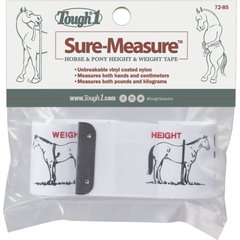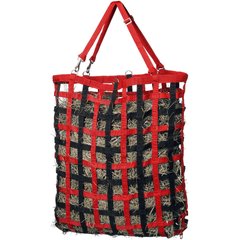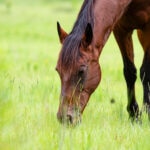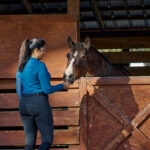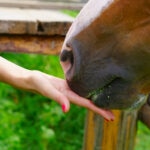How Much Hay Does a Horse Eat? Choosing the Best Hay for Horses

Photo by Alexia Khruscheva/iStock / Getty Images Plus via Getty Images
As herbivores, horses primarily eat forage like grass and hay, but how much hay does a horse eat? A number of variables, including age, workload, and the type of hay, can affect how much hay your horse should eat.
How Much Hay Does a Horse Eat a Day?
To determine how much horse hay to feed, you first need to choose between round and square bales.
- Round bales: Round bales weigh about 1,000 pounds and are placed in a field or paddock for horses to eat at will. So you’ll only be able to measure hay in precise amounts if you feed square bales.
- Square bales: Square horse hay bales weigh an average of 40–60 pounds each. During the baling process, square bales are compressed in a way that makes them break apart into roughly equal sections called “flakes” when opened. Many horse owners measure their horses’ hay meals by the flake. However, horse hay flakes can vary greatly in weight and caloric density.
It’s better to feed hay by weight than by the flake, says Arabian horse breeder Adrienne Morstad of Candelight Farms in New Milford, Connecticut, whose herd ranges from weanlings to seniors.
“The rule of thumb is 2% of [a horse’s] body weight,” she says. “So a 1,000-pound horse will need around 20 pounds of hay a day. This will vary by individual horses’ needs, and the quality of hay given.”
“For an adult horse in work, the starting point is 1.5% to 2.5% of body weight per day,” adds Grey Parks, MS, equine nutritionist at ProTrition in La Vergne, Tennessee. “1.5% is for those easy keepers that tend to gain weight. Hard keepers or growing horses may need 2.5%. Offered free choice hay, some horses will eat 3% or more of their body weight per day.”
A height and weight tape will tell you approximately how much your horse weighs. However, a livestock scale, which is available to use at many large-animal veterinary hospitals, will give you a more precise number.
If you’re aiming for 2%, just multiply your horse’s weight by 0.02 to get their total hay ration per day. You can weigh horse hay with a hay bag and a hanging scale.
Recommended Products
Horses with access to grass may not need hay for much of the year.
“Pastures are widely variable,” Morstad says. “A well-managed pasture with ample forage can provide enough feed without additional hay, but this should be monitored closely.”
The quality of a pasture will depend on soil nutrient levels and the variety of grasses grown. During the winter, most pastured horses will require hay to maintain a healthy weight.
What Is in Hay for Horses?
Horses eat many different types of hay. The choice of hay depends on each horse’s nutritional needs, as well as horse hay availability and price.
“Matching the hay to the horse is the main concern,” Parks says. “If you have easy keepers, you don’t want a high-calorie diet. If you have weanlings and yearlings, they may not be able to extract enough nutrition from mature grass hay. [The] next concern is what’s consistently available at a high level of quality: clean, not super stalky, with no weeds.”
Alfalfa Hay for Horses
Alfalfa is a legume related to peas. It’s more nutrient-dense than grass hays, with lots of protein and calcium. This makes alfalfa a good choice for high-energy horses such as:
- Performance horses
- Schooling horses used for daily lessons
- High-strung horses
- Young or growing horses
Parks recommends feeding between 25% and 75% alfalfa to high-performance equine athletes, provided they don’t gain excess weight on this ration.
However, an all-alfalfa diet may actually provide too much protein, which could reduce athletic performance. Horses fed mostly alfalfa, particularly in the western United States, may also be at a higher risk for enteroliths—intestinal stones that can cause colic. Hay grown in the West generally contains high mineral and protein content in alfalfa hay, which affects the pH levels in a horse’s colon.
Timothy Hay for Horses
Timothy grass produces a well-balanced hay containing approximately 8% protein. Most horses eat timothy hay readily.
However, growing horses, pregnant horses, and horses in heavy work may need more calories than they can get from timothy hay alone.
Timothy also tends to be a costlier option than most other grass hays, which may put it out of reach for some horse owners.
Orchard Grass Hay for Horses
At up to 12% protein, orchard hay delivers more energy for hard-working horses than timothy hay. However, this also means orchard might be less ideal for horses with equine metabolic syndrome (EMS) or for sedentary horses that tend toward obesity.
Like timothy, orchard hay can be expensive.
Bermuda / Coastal Hay for Horses
Hay labeled as “Bermuda” or “coastal” may come from any of several related grass varieties, collectively called “Bermudagrasses.” These grasses grow well in warm climates, making Bermuda hay widely available and fairly affordable.
However, Bermuda hay may be associated with colic in horses.
“The variety implicated in a particular type of impaction colic is coastal Bermuda grass,” says Parks. “Coastal tends to have a relatively fine blade even when mature and high in non-digestible fiber, so a horse may eat quite a bit of it when it is not very digestible, then it can impact.”
Parks recommends diluting coastal Bermuda hay by feeding some alfalfa alongside it and choosing a different type of hay for horses with a colic history.
Teff Hay for Horses
Teff is lower higher in fiber and low in sugar and starch than most other grass hays, which makes it a good choice for horses with EMS. It’s also an ideal forage for retired horses and those that tend to gain weight when fed more caloric hays.
Horses with an increased need for energy can still eat teff, but they may need an additional, richer forage alongside it, such as alfalfa, to maintain their weight.
Teff hay is relatively affordable compared to other grass hays but it has recently increased in price due to its growing popularity.
What To Look for in Healthy Horse Hay
“Horse owners love to judge hay by the color, but that can be misleading, especially with modern hay producers, who may use preservative sprays that are harmless to horses but do keep hay green no matter what,” says Parks.
Instead, she suggests this three-step process:
- Learn to recognize the grass species you’re buying, so that you know if that bale labeled “timothy” or “orchard” is the type of grass you paid for.
- Inspect the hay for common weeds, especially ones that can harm horses, like foxtail.
- Use your nose and eyes to check for moldy hay. Reject any bales with a moldy or mildewy smell. Peel off a couple of flakes and look for a rising puff of white dust, which is likely to be mold. (Ordinary, brown dust is generally harmless to horses.)
Even after you’ve purchased a batch of hay, inspect every bale you plan on giving at feeding time, and throw out any that appear to be contaminated.
How To Choose Hay Feeders for Horses
Many horse owners feed hay in simple plastic or metal tubs. There’s nothing wrong with that, if it works for you and your horse. However, an increasing proportion of owners feed hay in slow feeders.
Recommended Product
Horse owners like using slow feeders for several important reasons:
- Slow feeders reduce hay waste.
- Slow feeding stretches mealtime across several hours, reducing the chance that horses’ stomachs will empty completely before their next meal. An empty stomach can increase the risk of gastric ulcers in horses and colic.
- The use of slow feeders in captivity helps to simulate horses’ natural “time budget,” which is mostly spent on grazing in the wild.
- Some horses are prone to choke when they eat hay too quickly.
If you’re interested in trying a slow feeder, consider starting with a small mesh slow-feeding hay net. A 2023 study found these nets were effective at increasing the duration of chewing in horses eating bermudagrass hay.
FAQs About Horse Hay
How many flakes are in a bale of hay?
For most varieties of hay, you can expect 12–15 flakes per square bale. Hay meals for horses should be measured by weight, not by the flake.
Is alfalfa good for horses?
Yes, alfalfa hay is a good fit for some horses, depending on their age, lifestyle, and level of exercise. It’s always a good idea to discuss the best hay type with your veterinarian for your specific horse’s needs.
What is the best hay for horses?
Hay should be selected based on each horse’s individual needs. Consider your horse’s age, workload, ideal weight, and health history when choosing the best hay for your horse.
This content was medically reviewed by Jennifer Rice, DVM, CVSMT, Chewy veterinarian.
